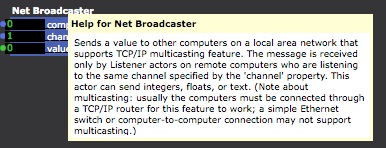Passing information between scenes
-
I did something similar looping back OSC through a max patch. I didn't need worry about activating scenes as the Max patch acted like a buffer sending the last data to the new scene.
I should read the manual more and learn about things like the data array. -
I basically want to give a mac mini a static IP address and then be able to send a 'ping' which re-sets the patch. Is this possible?
-
Yes Skulpture you can send pings via OSC to IP addresses.
Exactly what constitutes the ping is up to you to decide and parse on the Mac mini side. This could act as a trigger to recall a snapshot. -
What are you considering 'reset' for this patch.
-
I've been testing the Broadcaster/Listener and also the Data Array.
The broadcaster works once with the scenes active, then becomes inactive so I have to always retrigger it a lot to reactivate the scenes. And then there's the problem of making 5 scenes active all the time. I like it, but I don't think it'll work for this install.The data array works well except for when I reenter the scenes it updates the picture and there is a visual flash/glitch.So close on both, but not quite there.I'll have to rethink and reconfigure the flow on this one.Thanks All. -
If you use 1 scene for data and ensure that it contains all values at all times, you should be able to keep it active at all times... and activate a second scene as needed.
I generally I call these scenes my 'Jumper', since they also contain all my Jump/transition logic. Usually its in Scene 1.If value updating is an issue you can put something like a trigger value and pulse actor to continually push values.Using this 'master' scene method has worked very well for me numerous times. To avoid flash/glitches in the data updates, you can activate the scene at 0.1 intensity.. make the updates, and then move the intensity up. Or patch the players so they Init to off, and wait for the values to arrive before starting.Data Array also works amazingly, but to avoid the flicker you are seeing you need to ensure that values are received first, and then playback is started. It can be important to remember that Isadora has a order of operations. If you need it done first, place it in the top left of your patch. -
@DusX its an interactive inside a museum and I have a patch that can reset the patch if something was to go astray, basically when the patch starts it:
- shows stage- starts video- selects a random picture- starts a timer- a few other bits; trigger values, etc.For some reason I don't think out network supports multi-casting TCP/IP because I gave the mac a static IP address (Just made it up) and I got nothing.I think if it was just a normal network and not a big institution it may work. -
if tcp multicasting is a problem, why do not try rtpMIDI software and just send control via old MIDI protocol over wifi?
-
DusX, That Master scene advice is excellent.
Sculpture can I ask why the network would need to support multicasting? I'm asking because I've not come across that before and forewarned is forearmed.Cheers -
I have been going off the help from the Net Broadcaster actor.
-
Ah, thanks. Learning a few gems from this thread.
Does the OSC Transmit actor not work for you? -
Nope. I think its the router we are using. Just spoke to our IT guy by chance and he thinks it's either firewalls or the outer type. We are using a R7000 from Netgear.
-
I can understand Multicast not being turned on in the router for performance reasons but I don't understand how OSC isn't getting through as it's just UDP packets. Maybe an overly cautious closing of firewall ports is the reason?
-
I have never used, Net Broadcaster...
I would like to, but haven't had need yet. Perhaps its something to add to my ToDo list.Right now I am doing a bunch of dev with Tcp-ip, but in a totally different way.I am running a small webserver that I can communicate with, it is working well for outgoing messages, but incoming like you are looking for would require leaving the connection open.. not sure how reliable that would be.